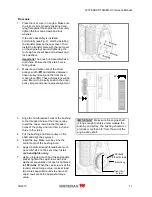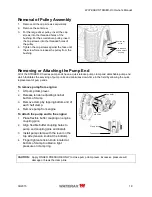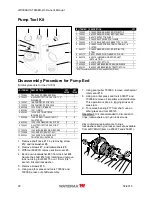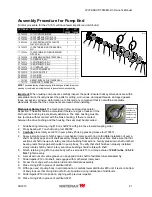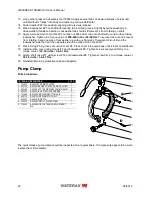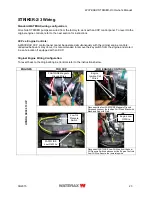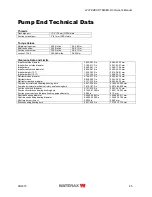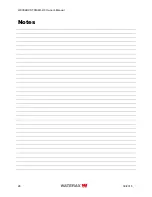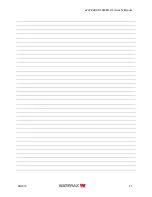
WATERAX
STRIKER-2/3 Owner's Manual
09/2015
13
Troubleshooting
This section provides brief troubleshooting instructions for verifying the set-up and
operation of the pump. Each section describes a condition and lists possible causes along
with a list of items to check to identify the source of the problem and resolve it.
Pump Loses Prime or Will Not Prime
Air Leaks
Attempt to locate and correct the air leaks by isolating each system component.
Disconnect the pump priming system and test. Check that the priming system is
pulling its rated vacuum.
Cap the pump discharge and prime the pump. If the pump primes, the leak is in
the pump discharge components. If the pump does not prime, the leak may be in
the pump, or the pump intake system.
Cap the pump intake and discharge and then perform a vacuum test on the
pump (15 to 30 in Hg). If the prime holds, then the leak is in the pump intake
components. If the pump does not hold prime, leakage could come from a port
or drain line attached to the pump.
Before repeating the test above, disconnect the drain line from the pump and
plug. If the pump holds vacuum, the leak is in the drain line or drain valve. If the
pump does not hold prime, leakage could be from another component attached
to a port in the pump.
Before repeating the test above one last time, remove any other component
connection from the pump and plug. Re-test the pump under vacuum. If the
pump holds prime, leakage was in one of the components removed. If the pump
does not hold prime, leakage is in the pump.
Air Trapped
in Suction
(Pump Intake)
Line
Check that no part of the suction hose or piping is higher than the pump intake.
Pump suction hose and piping must be laid out with a continuous decline to the
water source from the pump intake.
If the pump intake piping above the pump intake cannot be avoided, priming
taps must be added to the raised section of piping for the removal of trapped air.
If the suction hose cannot be laid out in a manner to avoid raised sections in the
hose, wiggle and raise the hose while priming to allow the entrapped air to work
its way from the raised region.
Check the priming port location. If the port is not located in a position that will
allow the eye of the impeller to fill with water, it will need to be moved to a
location that will do so.
Blocked or
Restricted
Intake Hose
or Strainer
Remove blockage from the intake hose or strainer.
Strainer should not be sitting at the bottom of the water source where debris can
be picked up. Clean off the strainer and raise to a position that is off the bottom
of the water source (floating strainers are available).
If the strainer is new, check that the strainer hole size is not too restrictive for the
demands of the pump.
Pump
Suction Lift
Requirements
are Too High
DO NOT attempt pump lifts exceeding 22 feet (6.7 meters) except at elevations
lower than 2000 feet above sea level.
As elevation increases above 2000 feet above sea level, maximum lift heights
will diminish. Check that the lift for the elevation the pump is being required to
operate at is achievable.
Inoperative
Priming
System
Check and service the priming system as outlined in the documentation from the
priming system’s supplier.



















